
You may be familiar with the effects of a restless night's sleep, including feeling groggy and fatigued throughout the day. If these symptoms are becoming more frequent and severe, it could be an indicator of a sleep disorder. Sleep disorders can range from snoring to more serious temporomandibular joint (TMJ) problems.
With so many types of sleep-related issues, it is important to understand what is happening in your body and how you can address each individually. We will look at common causes of disrupted sleep such as snoring, TMJ pain, and other underlying disorders that could be contributing to sleeplessness—providing you with tips on how to get a good night’s rest.
TMJ Overview
When you bite down hard, you put force on the object between your teeth and on the joint. In terms of physics, the jaw is the lever and the TMJ is the fulcrum. Actually, more force is applied (per square foot) to the joint surface than to whatever is between your teeth. To accommodate such forces and to prevent too much wear and tear, the cartilage between the mandible and skull normally provides a smooth surface over which the joint can freely slide with minimal friction.
Therefore, the forces of chewing can be distributed over a wider surface in the joint space and minimize the risk of injury. In addition, several muscles contribute to opening and closing the jaw and aid in the function of the TMJ.
- Symptoms include:
Ear pain - Sore jaw muscles
- Temple/cheek pain
- Jaw popping/clicking
- Locking of the jaw
- Difficulty in opening the mouth fully
- Frequent head/neck aches
What Can Be Done?
Because TMJ symptoms often develop in the head and neck, otolaryngologists are appropriately qualified to diagnose TMJ problems. Proper diagnosis of TMJ begins with a detailed history and physical, including careful assessment of the teeth occlusion and function of the jaw joints and muscles.
If the doctor diagnoses your case early, it will probably respond to these simple, self-remedies:
- Rest the muscles and joints by eating soft foods
- Do not chew gum
- Avoid clenching or tensing
- Relax muscles with moist heat (1/2 hour at least twice daily)
In cases of joint injury, ice packs applied soon after the injury can help reduce swelling. Relaxation techniques and stress reduction, patient education, non-steroidal anti-inflammatory drugs, muscle relaxants, or other medications may be indicated in a dose your doctor recommends.
Other therapies may include the fabrication of an occlusal splint to prevent wear and tear on the joint. Improving the alignment of the upper and lower teeth and surgical options are available for advanced cases. After diagnosis, your otolaryngologist may suggest further consultation with your dentist and oral surgeon to facilitate the effective management of TMJ dysfunction.
If you're struggling with a sleep disorder, trust the ENT & Allergy Associates team. We are the nation's largest ENT, allergy, and audiology practice and have the largest pool of board-certified and fellowship-trained physicians in their field. We are ready to help you get a good night's sleep again.
Contact ENT & Allergy Associates for help with your sleep disorders, snoring, or TMJ.

Patient Stories
-
"Dr. Vishwesh Mehta cured my ear problem with ease. He is the best Doctor. I am fully satisfied."
- Dilesh S. -
"Little bit of a wait but Dr. Rosin was attentive and very nice. Would recommend"
- Megan B. -
"Excellent service!!!! Excellent Doctor !!!!! Thank you so much!!!!!"
- Anand K.
Less Sick Days, More Living

